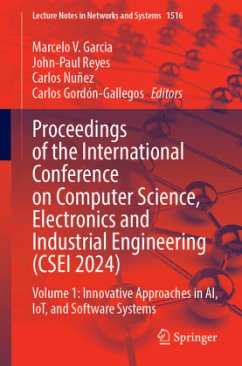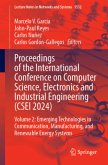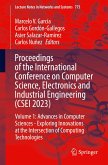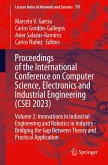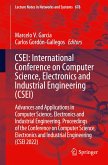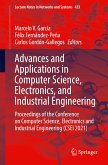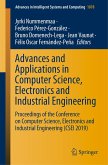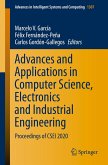Proceedings of the International Conference on Computer Science, Electronics and Industrial Engineering (CSEI 2024)
Volume 1: Innovative Approaches in AI, IoT, and Software Systems
Herausgegeben:Garcia, Marcelo V.; Reyes, John-Paul; Nuñez, Carlos; Gordón-Gallegos, Carlos
Proceedings of the International Conference on Computer Science, Electronics and Industrial Engineering (CSEI 2024)
Volume 1: Innovative Approaches in AI, IoT, and Software Systems
Herausgegeben:Garcia, Marcelo V.; Reyes, John-Paul; Nuñez, Carlos; Gordón-Gallegos, Carlos
- Broschiertes Buch
- Merkliste
- Auf die Merkliste
- Bewerten Bewerten
- Teilen
- Produkt teilen
- Produkterinnerung
- Produkterinnerung
This book captures extraordinary research from the VI International Conference on Computer Science, Electronics, and Industrial Engineering (CSEI 2024), where innovation meets real-world impact.
Discover how AI transforms lives in ways you never imagined. Researchers are helping doctors detect Parkinson's disease simply by analyzing handwriting, while others are creating smarter prosthetics that respond naturally to human thoughts. From fighting political propaganda to designing buildings that think, these breakthrough applications show AI's incredible potential to make our world…mehr
Andere Kunden interessierten sich auch für
![Proceedings of the International Conference on Computer Science, Electronics and Industrial Engineering (CSEI 2024) Proceedings of the International Conference on Computer Science, Electronics and Industrial Engineering (CSEI 2024)]() Proceedings of the International Conference on Computer Science, Electronics and Industrial Engineering (CSEI 2024)166,99 €
Proceedings of the International Conference on Computer Science, Electronics and Industrial Engineering (CSEI 2024)166,99 €![Proceedings of the International Conference on Computer Science, Electronics and Industrial Engineering (CSEI 2023) Proceedings of the International Conference on Computer Science, Electronics and Industrial Engineering (CSEI 2023)]() Proceedings of the International Conference on Computer Science, Electronics and Industrial Engineering (CSEI 2023)152,99 €
Proceedings of the International Conference on Computer Science, Electronics and Industrial Engineering (CSEI 2023)152,99 €![Proceedings of the International Conference on Computer Science, Electronics and Industrial Engineering (CSEI 2023) Proceedings of the International Conference on Computer Science, Electronics and Industrial Engineering (CSEI 2023)]() Proceedings of the International Conference on Computer Science, Electronics and Industrial Engineering (CSEI 2023)152,99 €
Proceedings of the International Conference on Computer Science, Electronics and Industrial Engineering (CSEI 2023)152,99 €![CSEI: International Conference on Computer Science, Electronics and Industrial Engineering (CSEI) CSEI: International Conference on Computer Science, Electronics and Industrial Engineering (CSEI)]() CSEI: International Conference on Computer Science, Electronics and Industrial Engineering (CSEI)151,99 €
CSEI: International Conference on Computer Science, Electronics and Industrial Engineering (CSEI)151,99 €![Advances and Applications in Computer Science, Electronics, and Industrial Engineering Advances and Applications in Computer Science, Electronics, and Industrial Engineering]() Advances and Applications in Computer Science, Electronics, and Industrial Engineering181,89 €
Advances and Applications in Computer Science, Electronics, and Industrial Engineering181,89 €![Advances and Applications in Computer Science, Electronics and Industrial Engineering Advances and Applications in Computer Science, Electronics and Industrial Engineering]() Advances and Applications in Computer Science, Electronics and Industrial Engineering113,99 €
Advances and Applications in Computer Science, Electronics and Industrial Engineering113,99 €![Advances and Applications in Computer Science, Electronics and Industrial Engineering Advances and Applications in Computer Science, Electronics and Industrial Engineering]() Advances and Applications in Computer Science, Electronics and Industrial Engineering113,99 €
Advances and Applications in Computer Science, Electronics and Industrial Engineering113,99 €-
-
-
This book captures extraordinary research from the VI International Conference on Computer Science, Electronics, and Industrial Engineering (CSEI 2024), where innovation meets real-world impact.
Discover how AI transforms lives in ways you never imagined. Researchers are helping doctors detect Parkinson's disease simply by analyzing handwriting, while others are creating smarter prosthetics that respond naturally to human thoughts. From fighting political propaganda to designing buildings that think, these breakthrough applications show AI's incredible potential to make our world better.
See how 5G, blockchain, and cloud computing are reshaping everything from healthcare to city water systems. Engineers are finding ingenious ways to power tiny IoT devices and help us navigate more intelligently through increasingly connected environments.
Learn how big data is driving the green revolution, optimizing everything from industrial processes to renewable energy systems. These aren't just theoretical concepts they're practical solutions addressing the sustainability challenges we face today.
What ties all this research together? A shared vision of technology that truly serves humanity:
AI that seamlessly integrates into every field, enhancing rather than replacing human expertiseSolutions designed with people at the center, not as an afterthoughtGreen technologies that protect our planet for future generationsSmart monitoring systems that help us make better decisions fasterCreative combinations of different technologies tackling complex, real-world problems
Whether you're a researcher pushing boundaries, a practitioner implementing solutions, an educator inspiring the next generation, or a student eager to change the world, this book offers both practical insights and inspiration. It's your window into the innovations shaping our technological future.
Discover how AI transforms lives in ways you never imagined. Researchers are helping doctors detect Parkinson's disease simply by analyzing handwriting, while others are creating smarter prosthetics that respond naturally to human thoughts. From fighting political propaganda to designing buildings that think, these breakthrough applications show AI's incredible potential to make our world better.
See how 5G, blockchain, and cloud computing are reshaping everything from healthcare to city water systems. Engineers are finding ingenious ways to power tiny IoT devices and help us navigate more intelligently through increasingly connected environments.
Learn how big data is driving the green revolution, optimizing everything from industrial processes to renewable energy systems. These aren't just theoretical concepts they're practical solutions addressing the sustainability challenges we face today.
What ties all this research together? A shared vision of technology that truly serves humanity:
AI that seamlessly integrates into every field, enhancing rather than replacing human expertiseSolutions designed with people at the center, not as an afterthoughtGreen technologies that protect our planet for future generationsSmart monitoring systems that help us make better decisions fasterCreative combinations of different technologies tackling complex, real-world problems
Whether you're a researcher pushing boundaries, a practitioner implementing solutions, an educator inspiring the next generation, or a student eager to change the world, this book offers both practical insights and inspiration. It's your window into the innovations shaping our technological future.
Produktdetails
- Produktdetails
- Lecture Notes in Networks and Systems 1516
- Verlag: Springer / Springer Nature Switzerland / Springer, Berlin
- Artikelnr. des Verlages: 978-3-031-98767-0
- Seitenzahl: 962
- Erscheinungstermin: Oktober 2025
- Englisch
- Abmessung: 235mm x 155mm
- ISBN-13: 9783031987670
- Artikelnr.: 74384887
- Herstellerkennzeichnung Die Herstellerinformationen sind derzeit nicht verfügbar.
- Lecture Notes in Networks and Systems 1516
- Verlag: Springer / Springer Nature Switzerland / Springer, Berlin
- Artikelnr. des Verlages: 978-3-031-98767-0
- Seitenzahl: 962
- Erscheinungstermin: Oktober 2025
- Englisch
- Abmessung: 235mm x 155mm
- ISBN-13: 9783031987670
- Artikelnr.: 74384887
- Herstellerkennzeichnung Die Herstellerinformationen sind derzeit nicht verfügbar.
Marcelo V. Garcia, Ph.D. (Scopus ID: 56597269000, Web of Science Researcher ID: J-3195-2019), is a researcher from INTELIA research group. He studied electronics and instrumentation engineering at the University of the Armed Forces-ESPE. In 2013, he obtained his master's degree in control, automation, and robotics engineering, and in 2018, he obtained his doctorate at the University of the Basque Country (UPV / EHU). His studies were carried out thanks to a grant from the Ecuadorian government. From 2008 to 2013 he worked as an engineer in different companies in the area of oil and gas in Ecuador such as Schlumberger, Petrobras, and Petroamazonas EP. His research interest is focused on the design of next-generation architectures based on Industry 4.0 in various domains such as automation and smart manufacturing.
John-Paul Reyes, Ph.D. (Scopus ID: 57194871610), is a full professor at the Universidad Técnica de Ambato. He holds Ph.D. in industrial engineering and production from the Universitat Politècnica de València (UPV), Spain. He has worked as a consultant for mining and footwear companies, where he has participated in logistical, operational, and management processes, as well as in the area of risk analysis. His research interests include information technologies, industrial engineering, supply chain management, operations research, lean manufacturing tools, business process management, modeling, and simulation.
Carlos Nuñez M., Mg. (Scopus ID: 57201028703), received his engineering in computer and information systems and the Mg. in database management from the Technical University of Ambato (UTA) Ecuador in 2006 and 2012, respectively. He has written more than ten SCOPUS scientific papers. His current research interests include software artificial intelligence and database. Currently he is a coordinator of the Operational Research Unit of the Faculty of Engineering in Electronic and Industrial Systems and a general coordinator of the Network of the Technical University of Ambato.
Carlos Gordon Gallegos, Ph.D. (Scopus ID: 56419359600), received his electronic engineering and the M.Sc. degree in networks and telecommunications from the Technical University of Ambato (UTA) Ecuador in 2005 and 2010, respectively. He joined the Department of Optoelectronics and Laser Technology, Universidad Carlos III de Madrid, UC3M, Madrid, Spain, in 2012, and he received Ph.D. degree in electrical, electronics, and automation engineering in 2016, under the supervision of Prof. Guillermo Carpintero del Barrio. He has written more than sixty SCOPUS scientific papers. His current research interests include photonic integrated circuits in InP for the Millimeter-wave & Terahertz signal generation for high data rate wireless communication systems, the semiconductor short-pulse laser systems, artificial intelligence in robotics, and renewable energy.
John-Paul Reyes, Ph.D. (Scopus ID: 57194871610), is a full professor at the Universidad Técnica de Ambato. He holds Ph.D. in industrial engineering and production from the Universitat Politècnica de València (UPV), Spain. He has worked as a consultant for mining and footwear companies, where he has participated in logistical, operational, and management processes, as well as in the area of risk analysis. His research interests include information technologies, industrial engineering, supply chain management, operations research, lean manufacturing tools, business process management, modeling, and simulation.
Carlos Nuñez M., Mg. (Scopus ID: 57201028703), received his engineering in computer and information systems and the Mg. in database management from the Technical University of Ambato (UTA) Ecuador in 2006 and 2012, respectively. He has written more than ten SCOPUS scientific papers. His current research interests include software artificial intelligence and database. Currently he is a coordinator of the Operational Research Unit of the Faculty of Engineering in Electronic and Industrial Systems and a general coordinator of the Network of the Technical University of Ambato.
Carlos Gordon Gallegos, Ph.D. (Scopus ID: 56419359600), received his electronic engineering and the M.Sc. degree in networks and telecommunications from the Technical University of Ambato (UTA) Ecuador in 2005 and 2010, respectively. He joined the Department of Optoelectronics and Laser Technology, Universidad Carlos III de Madrid, UC3M, Madrid, Spain, in 2012, and he received Ph.D. degree in electrical, electronics, and automation engineering in 2016, under the supervision of Prof. Guillermo Carpintero del Barrio. He has written more than sixty SCOPUS scientific papers. His current research interests include photonic integrated circuits in InP for the Millimeter-wave & Terahertz signal generation for high data rate wireless communication systems, the semiconductor short-pulse laser systems, artificial intelligence in robotics, and renewable energy.
Part 1: Applications of Artificial Intelligence Section.- Chatbot for help in gynecology and obstetrics areas.- Ant colony algorithm for supplying medicines to regional hospitals in a CVRP scenario. Case study: Peru during COVID-19.- Call of duty or call of dependency: Estimation of video game addiction based on Reddit data.- Sentiment analysis of a social network to detect political propaganda.- Artificial intelligence to forecast precipitation levels in urban areas of Santo Domingo-Ecuador.- Systematic review of pre-trained models for real-time translation from Spanish to Colombian sign language.- Intelligent system for gardens with artificial vision.- Detection of criminal situations for surveillance in commercial establishments.- Application of digital forensic techniques to identify synthetic DeepFake audios.- An ensemble deep learning model for early detection of Parkinson's disease through handwriting analysis.- Disruptive innovation: a systematic review of the impact of generative artificial intelligence (AI) on cybersecurity.- AI-driven architecture: automating space planning and building mass generation.- Artificial intelligence to identify factors linking with purchase intention in restaurants in Ecuador.- Use of LSTM recurrent neural network for flow prediction of a mini hydroelectric power plant using open-source software.- Artificial intelligence model for the characterization of Lung Tumors using fractal dimension estimation.- Neuro-PID control for temperature optimization in floricultural air conditioning systems.- A multi-agent architecture with deep reinforcement learning: Reducing interactions with the environment through knowledge communication.- Comparing Deep Q-learning and reinforcement learning agents in myoelectric hand prosthesis control.- Web scraping suggestion engine for athletic footwear purchase decision making.- Detection of stress levels in university students from electrophysiological signals using machine learning techniques.- Inclusive tourism: Evaluation of disabled users' opinions on social networks.- Comparison of machine learning algorithms for SDN optimization using TOPSIS methodology.- The role of quantum computing and learning automatic in advancing medical prediction systems.- Text mining techniques to detect psychological problems caused by the pandemic induced by COVID-19.- Predictive analysis of academic performance using logistic regression.- Early diagnosis of dengue fever using blood chemistry analysis and artificial intelligence-based predictive modelling.- VPD monitoring with ESP32 and flask API for early detection of powdery mildew in rose greenhouses.-Optimized agent-based coordination for distributed treasure hunts: A multi-agent systems approach.- Part 2: Communication technologies and systems section.- Analysis of child pornography offenses through special investigation techniques incorporating the role of undercover computer agent.- Blockchain and its impact on smart contracts: A comprehensive systematic review.- Cloud computing and its impact on healthcare services: A systematic review and bibliometric analysis.- Artificial vision system for validating personal protective equipment in advertising companies.- Gilbert cell mixer with frequency divider for radio frequency applications.- Success factors for a Fintech start-up: A systematic literature review.- Virtual navigation assistant and route generation in indoor spaces.- Smart electronic visor for navigation assistance for motorcycle riders.- Biomechanics-based electronic correction system for athletic gait correction for athletic walkers.- Integral plan for environmental awareness induction based on household waste.- Advancements in urban water consumption management: A review of digital transformation through smart meters, management platforms, and artificial intelligence.- Predictive models and factors for Keratoconus detection: A systematic review of the literature.- Self-sustainable platform for advanced monitoring of meteorological and seismic parameters at the Universidad Técnica de Ambato.-Enhanced positioning through deep learning in 5G mobile networks.- Aspects developed for the detection of diabetic retinopathy: A systematic literature review.- Sigfox in emerging cities: Challenges and opportunities in urban geolocation.- Network automation using python scripts with the Telnetlib Library and the Telnet protocol.- Real-time network information management using floodlight in convergence with SDN.- Intelligent edge-IoT platform for corn yield prediction.-Multiple sequence alignment of transmembrane proteins methods: A systematic review.- Mobile ambient air quality monitoring system using drones: Case study Ambato-Ecuador.- Wireless power transmission system for a nano network with IoT terminals in 5G networks.- Energy collection and storage system for a nano network for IoT terminals in 5G networks.- Part 3: Optimizing renewable energy and industrial informatics with big data and cloud computing section.- Reverse engineering applied to the ECOWITT WS90 meteorological station.- Numerical analysis of an agitated vessel with a draft tube using the sliding mesh approach and the SST k- turbulence model.- Numerical solution of the Black-Scholes equation and examples of application in financial decision-making .- Algorithm for detection of bone pathologies in chest radiographs.- Comparative study of optimization strategies for the production of galvanized steel sheet ventilation ducts using discrete event simulation software.
Part 1: Applications of Artificial Intelligence Section.- Chatbot for help in gynecology and obstetrics areas.- Ant colony algorithm for supplying medicines to regional hospitals in a CVRP scenario. Case study: Peru during COVID-19.- Call of duty or call of dependency: Estimation of video game addiction based on Reddit data.- Sentiment analysis of a social network to detect political propaganda.- Artificial intelligence to forecast precipitation levels in urban areas of Santo Domingo-Ecuador.- Systematic review of pre-trained models for real-time translation from Spanish to Colombian sign language.- Intelligent system for gardens with artificial vision.- Detection of criminal situations for surveillance in commercial establishments.- Application of digital forensic techniques to identify synthetic DeepFake audios.- An ensemble deep learning model for early detection of Parkinson's disease through handwriting analysis.- Disruptive innovation: a systematic review of the impact of generative artificial intelligence (AI) on cybersecurity.- AI-driven architecture: automating space planning and building mass generation.- Artificial intelligence to identify factors linking with purchase intention in restaurants in Ecuador.- Use of LSTM recurrent neural network for flow prediction of a mini hydroelectric power plant using open-source software.- Artificial intelligence model for the characterization of Lung Tumors using fractal dimension estimation.- Neuro-PID control for temperature optimization in floricultural air conditioning systems.- A multi-agent architecture with deep reinforcement learning: Reducing interactions with the environment through knowledge communication.- Comparing Deep Q-learning and reinforcement learning agents in myoelectric hand prosthesis control.- Web scraping suggestion engine for athletic footwear purchase decision making.- Detection of stress levels in university students from electrophysiological signals using machine learning techniques.- Inclusive tourism: Evaluation of disabled users' opinions on social networks.- Comparison of machine learning algorithms for SDN optimization using TOPSIS methodology.- The role of quantum computing and learning automatic in advancing medical prediction systems.- Text mining techniques to detect psychological problems caused by the pandemic induced by COVID-19.- Predictive analysis of academic performance using logistic regression.- Early diagnosis of dengue fever using blood chemistry analysis and artificial intelligence-based predictive modelling.- VPD monitoring with ESP32 and flask API for early detection of powdery mildew in rose greenhouses.-Optimized agent-based coordination for distributed treasure hunts: A multi-agent systems approach.- Part 2: Communication technologies and systems section.- Analysis of child pornography offenses through special investigation techniques incorporating the role of undercover computer agent.- Blockchain and its impact on smart contracts: A comprehensive systematic review.- Cloud computing and its impact on healthcare services: A systematic review and bibliometric analysis.- Artificial vision system for validating personal protective equipment in advertising companies.- Gilbert cell mixer with frequency divider for radio frequency applications.- Success factors for a Fintech start-up: A systematic literature review.- Virtual navigation assistant and route generation in indoor spaces.- Smart electronic visor for navigation assistance for motorcycle riders.- Biomechanics-based electronic correction system for athletic gait correction for athletic walkers.- Integral plan for environmental awareness induction based on household waste.- Advancements in urban water consumption management: A review of digital transformation through smart meters, management platforms, and artificial intelligence.- Predictive models and factors for Keratoconus detection: A systematic review of the literature.- Self-sustainable platform for advanced monitoring of meteorological and seismic parameters at the Universidad Técnica de Ambato.-Enhanced positioning through deep learning in 5G mobile networks.- Aspects developed for the detection of diabetic retinopathy: A systematic literature review.- Sigfox in emerging cities: Challenges and opportunities in urban geolocation.- Network automation using python scripts with the Telnetlib Library and the Telnet protocol.- Real-time network information management using floodlight in convergence with SDN.- Intelligent edge-IoT platform for corn yield prediction.-Multiple sequence alignment of transmembrane proteins methods: A systematic review.- Mobile ambient air quality monitoring system using drones: Case study Ambato-Ecuador.- Wireless power transmission system for a nano network with IoT terminals in 5G networks.- Energy collection and storage system for a nano network for IoT terminals in 5G networks.- Part 3: Optimizing renewable energy and industrial informatics with big data and cloud computing section.- Reverse engineering applied to the ECOWITT WS90 meteorological station.- Numerical analysis of an agitated vessel with a draft tube using the sliding mesh approach and the SST k- turbulence model.- Numerical solution of the Black-Scholes equation and examples of application in financial decision-making .- Algorithm for detection of bone pathologies in chest radiographs.- Comparative study of optimization strategies for the production of galvanized steel sheet ventilation ducts using discrete event simulation software.

